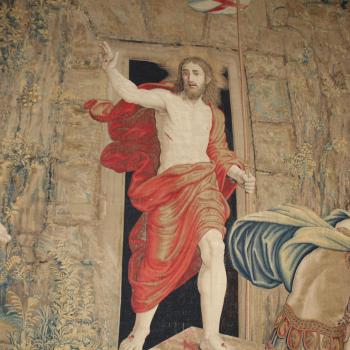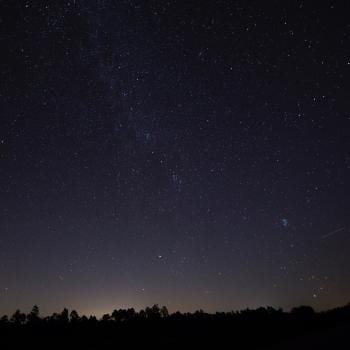Embracing Resurrection without Supernaturalism
There is no getting around Easter if you belong to the Jesus movement. Jesus’ first followers were transformed by their encounters with the Risen Christ. Once fearful, they became courageous; once uncertain, they became confident in that Jesus was unique, the savior of humankind, victorious over sickness, sin, and death. Something happened – something amazing – that changed everything, that raised their dead spirits and energized their lives.
The power of the resurrection to transform lives can’t be denied by any honest observer. For two thousand years, the amazing power of Jesus’ resurrection has brought healing and wholeness – indeed new birth – to peoples’ lives.
Moreover, within span of some of their lifetimes or the lifetimes of their closest confidants, the written gospels emerged and with them the clear but amazing affirmation that Christ is alive and that both cross and resurrection are central to the good news of our healing and salvation. Something dramatic happened that can’t be reduced to a tall tale, repetition of myths of death and rebirth, or a rotting corpse. Something mysterious and amazing occurred that can’t be confined by a literalist understanding of the biblical stories. As the gospel of John proclaims, there is always more to Jesus than our own fabrications or the written text: his life, death, and resurrection will always transcend and sometimes transform the rational mind, opening the mind to a deeper rationalism in which all is wonder and miracle. “Now Jesus did many other signs in the presence of his disciples, which are not written in this book. But these are written so that you may come to believe that Jesus is the Messiah, the Son of God, and that through believing you may have life in his name.” (John 20:30)
The resurrection will always remain a mystery, hidden from rationalists and literalists alike. It is always more than we can ask or imagine. Some try to domesticate the Easter message by positing the creation of fanciful stories, recycled death-rebirth myths, trying to locate Jesus’ tomb and the corpse buried within, or suggesting that dogs ate the bones. The gospels even suggest that a rumor arose among the religious leaders that Jesus’ corpse had been stolen by his followers. But the gospels make plain that a stolen body can’t inspire a spiritual revolution. Others try to control the story by literalizing flesh and bone and questioning the piety of those who provide imaginative visions of the resurrection or seek to discern the events beneath the texts. The quest for the resurrected Jesus is often an act of faith. Still, we can’t separate the pre-Easter or post-Easter Christ, or the Christ of history and the Christ of faith: they are one holistic reality that transformed cells and souls in the first century and continues to do so today. The power of each energizes the power of the other.
We can never fully encompass Jesus’ resurrection, but we can find a clue in C.S. Lewis’ Chronicles of Narnia. As the tale goes, in order to save Edmund, the lion-savior Aslan must sacrifice his own life. The White Witch, however, is unaware of the laws of Deeper Magic, which promise resurrection to the innocent victim. Aslan rises and the White Witch and her minions are defeated. The Deeper Magic embedded in the creation of the universe is mysterious, but it is part of the larger causal interdependence of the universe; in fact, it may be its animating energy. The resurrection of Aslan does not circumvent the laws of nature but occurs as a result of deeper laws of nature. This opens the door to seeing resurrection as part of God’s amazing universe and affirming that certain moments can be so closely aligned to God’s vision that unexpected and transformative energies can be released, radically changing cells and souls.
As I ponder the great story of the universe, the emergence of galaxies and life on our planet, I am left not only with a sense of the randomness in the evolutionary process but also a sense of wonder that continues to give birth and energize our universe. In the evolution of galaxies, solar systems, planets, and earth species, amazing things occur that go far beyond – while including -randomness and accident. To quote Abraham Joshua Heschel, “radical amazement” is the appropriate response to the universe and our own microcosmic lives.
Although it is fruitless to explain resurrection, it is clear to me that throughout his ministry Jesus tapped into deeper energies to promote the transformation of bodies, minds, and spirits. The energy of the universe flowed through Jesus, in response to a woman’s faith, immediately curing her of a hemorrhage. A Samaritan woman’s child is healed at a distance of a mysterious disease through the interplay of her faith and Jesus’ intentionality. Waves are calmed as a result of Jesus’ spiritual powers. All of these amazing events can be understood in light of the interdependent and energetic nature of the universe, described by cosmology, physics, and biology. The congruence of faith and science hardly minimizes our wonder but places our wonder in the context of an entirely wonderful universe, of which we are mostly oblivious.
There is a deeper naturalism, dynamic, open-ended, many-faceted, and containing random events, and even using randomness as the springboard for the energy of love to transform the world. But even random events are touched by a gentle providence that moves through the universe, giving direction and life to personal, communal, planetary, and cosmic evolutions. Resurrection does not defy the causal relatedness of life or the dynamic laws of nature but reflects the deeper energetic nature of reality which is always amazing and revelatory of more than we can ask or imagine.
What, then, happened on Easter morning? While we may never know for sure and should never domesticate such amazing moments, let me suggest that Jesus’ resurrected body incarnated the deeper laws of the universe that were already manifest in his ministry of healing and hospitality. Perhaps, Jesus’ resurrection body became a highly charged quantum body, able to move from one place to another in a blink of an eye and move through dense material bodies, such as walls, as if they were air. While we can’t literalize the gospel stories, the affirmation that Jesus was recognized by his followers and known by his wounds points to a continuity of his post- resurrection body with his pre-resurrection body. Such events are possible in a lively, dynamic universe, and are surely no more marvelous than invoking the big bang as the first moment of our universe. How can one not be amazed to recognize that from a microcosmic energy event a universe of 125 billion, and counting, galaxies emerged? All is natural, yet all amazing, mysterious, and beyond our imaginations.
This Easter, open to possibility, awaken to wonder, and look for hints of Jesus’ resurrection in your own cells, your spirit, and the world around. Look for miracles and, as Wendell Berry counsels, practice resurrection. You will discover in great mystery and wonder that Christ is Risen in your life – today!
+++
Bruce Epperly is a pastor, professor, and author of over sixty books, including “Talking Politics with Jesus: A Process Perspective on the Sermon on the Mount,” “Mystics in Action: Twelve Saints for Today,” “Walking with Francis of Assisi: From Privilege to Activism,” “Angels, Mysteries, and Miracles: A Progressive Vision,” and “Prophetic Healing: Howard Thurman’s Vision of Contemplative Activism.” He may be reached at [email protected]
+++
Holy Saturday
During Holy Week, most of us focus on the palms, the passion, and the resurrection, leaping over the wilderness of Holy Saturday. The movement from celebration to desolation and surprising celebration again characterizes not only Holy Week but the realities of a meaningful life. We can’t escape suffering but our suffering is often transformed into joy by surprising events or unexpected insights and experiences. In the shadow of loss, the light of new birth often emerges.
For many Protestants – but also for Roman Catholic and Orthodox Christians – Holy Saturday is a forgotten day. We experience the juxtaposition of the Passover, Eucharist, and betrayal of Maundy Thursday, and the darkness of Good Friday, but usually devote Saturday to preparing for our Easter feasts and egg hunts. Still, I believe there is good reason to see Holy Saturday as a key movement in Holy Week and a window into the realities of life.
Holy Saturday is the day of suspense and uncertainty, clouded over by tragedy and suffering. Nothing happens and nothing is expected. The future is in doubt and Jesus’ followers wonder if they will ever be able to hope again. That Saturday must have appeared to go on forever as grief, fatigue, fear, hopelessness, and shame filled their spirits. Is Jesus really dead? Has God’s vision of Shalom been defeated? Was his message true or just another pipe dream? And when they looked at their own lives, Jesus’ followers struggled with personal uncertainty. Would they ever celebrate again? Could they ever live with themselves after abandoning the One who loved them? Was their faith misplaced and misguided?
Holy Saturday’s suspense reminds us of many of our own lives. These days we live in suspense. We have lived with the suspense of COVID for two years, and we just as we see the contours of a new day with COVID a new variant appears. Believing ourselves superior morally to our predecessors, we witness Russia’s invasion of Ukraine and the attending war crimes and genocide. Proud of our democracy and education, we witness in unbelief the insurrection of January 6, the rise white Christian nationalism, and the widespread anti-science and anti-democratic factions in our nation persist. Our lives have changed radically, and the dark side of our nation has been revealed. Many of us deal with broken hearts, lost loves, chronic illnesses, failure and joblessness, hopelessness, alienation, and life-threatening illnesses. We remember good days in the past but experience the disorientation of the present and wonder if the darkness and depression will ever lift.
Holy Saturday reminds us of our global and national uncertainty. We wonder how well we will survive as a nation the economic and social cost of COVID, the attack on democracy, the rise in racism and incivility, the vitriol and bloviation of leaders, the polarization of the body politic, and the threat of World War III.
Holy Saturday reminds us that we can’t skip over the rough spots in Holy Week and in our own lives to get to the happy ending – the resurrection of Jesus and God’s triumph over death in all its forms. We need to remember that Jesus’ first followers were caught up in a Sabbath interlude and had no expectation of resurrection.
While we live in a world of familiar stories of triumph and new life, I suggest that we take a few minutes on Holy Saturday to contemplate Holy Week as if there were no Easter. What would it be like to live through Holy Week if there were no guarantee of an empty tomb and open future? What if we had no hope for a better world, or for our own transformation? Although we can’t obliterate our Easter memories, we can bracket them for a few hours of meditation, imaginative prayer, or a long walk with no pre-planned destination. We can reflect on the uncertainties and suspense-filled situations in our own lives. We can ponder possible futures in which there may not be a happy ending.
Such reflection is not sentimental melancholia but an invitation to see the whole picture of life – the realism of loss and uncertainty and the deeper realism of new life emerging out of the darkness of the earth and the hopelessness of the grave. If we live with the realism of a world without resurrection, then, when it happens: Easter will burst forth in ways that surprise and change us if we take pause to experience the Holy Saturdays of our lives. We will know the joy of healing, of resurrection, and new life and will join the first women and men in joyful celebration. We will be inspired to “practice resurrection” – to be prophets of a deeper reality, the reality of divine healing love and global transformation – in a world of real uncertainty and real pain.
+++
Bruce Epperly is a pastor, professor, and author of over sixty books, including “Talking Politics with Jesus: A Process Perspective on the Sermon on the Mount,” “Mystics in Action: Twelve Saints for Today,” “Walking with Francis of Assisi: From Privilege to Activism,” “Angels, Mysteries, and Miracles: A Progressive Vision,” and “Prophetic Healing: Howard Thurman’s Vision of Contemplative Activism.” He may be reached at [email protected]












